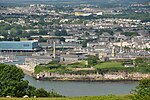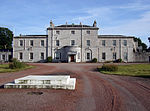Royal William Victualling Yard

The Royal William Victualling Yard in Stonehouse, a suburb of Plymouth, England, was the major victualling depot of the Royal Navy and an important adjunct of Devonport Dockyard. It was designed by the architect Sir John Rennie and was named after King William IV. It was built between 1826 and 1835 and occupies a site of approximately 16 acres (65,000 m2) being half of Western Kings, north of Devil's Point. The Yard was released from the Ministry of Defence (MOD) in 1992 and subsequently passed to the Plymouth Development Corporation. Upon the Corporation's closure in 1999, the Yard was then passed to The South West Regional Development Agency (SWRDA) who funded and carried out the extensive c. £60m restoration of the structural fabric of the majority of principal buildings and infrastructure within the yard between 1999 and 2008. During this period the buildings were recategorised from Scheduled Monuments to Grade I/II listed buildings. Private sector development partners Urban Splash were then engaged to carry out the specialist conversion of the site into a mixed-use development. Described as the grandest of the royal victualling yards, 'in its externally largely unaltered state it remains today one of the most magnificent industrial monuments in the country'.
Excerpt from the Wikipedia article Royal William Victualling Yard (License: CC BY-SA 3.0, Authors, Images).Royal William Victualling Yard
Admiralty Road, Plymouth Stonehouse
Geographical coordinates (GPS) Address Nearby Places Show on map
Geographical coordinates (GPS)
| Latitude | Longitude |
|---|---|
| N 50.3617 ° | E -4.16475 ° |
Address
Admiralty Road
PL1 3RS Plymouth, Stonehouse
England, United Kingdom
Open on Google Maps







